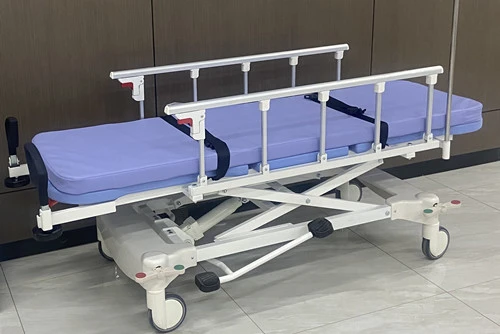How to Choose a High-Quality Medical Transfer Be
2024-03-22 14:45:58
In the realm of small-scale laboratories, the significance of selecting a high-quality medical transfer bed cannot be overstated. These beds serve as fundamental components in ensuring the safety and comfort of patients during transfers within medical facilities. With a plethora of options available in the market, navigating through the features and specifications to identify the most suitable transfer bed for your laboratory can be daunting. In this comprehensive guide, I will delve into the essential factors to consider when choosing a high-quality medical transfer bed tailored to the specific needs of small laboratories.

Understanding the Importance of Medical Transfer Beds
Before delving into the intricacies of selecting the ideal medical transfer bed for small laboratories, it is imperative to comprehend the significance of these essential pieces of equipment. Medical transfer beds play a pivotal role in facilitating the seamless transfer of patients between different areas within a medical facility. Whether it be moving patients from a stretcher to an examination table or transferring them between departments, the efficiency and safety ensured by a high-quality transfer bed are paramount.
Assessing Patient Needs and Requirements
One of the primary considerations when choosing a medical transfer bed for a small laboratory is assessing the unique needs and requirements of the patients who will be utilizing the equipment. Factors such as patient mobility, size, and medical condition must be taken into account to ensure optimal comfort and safety during transfers. Additionally, considerations regarding the frequency and nature of transfers within the laboratory setting should inform the selection process.
Ergonomic Design and Accessibility Features
Ergonomic design and accessibility features are integral aspects of a high-quality medical transfer bed, particularly in the context of small laboratories where space constraints may be a factor. Look for beds equipped with features such as adjustable height, side rails, and easy-to-operate controls, which enhance accessibility and facilitate smooth transfers while minimizing the risk of injury to both patients and healthcare providers.
Durability and Maintenance Considerations
In a small laboratory setting where resources may be limited, investing in a durable and low-maintenance medical transfer bed is crucial. Prioritize beds constructed from high-quality materials that can withstand the rigors of daily use without compromising on safety or functionality. Additionally, consider factors such as ease of cleaning and maintenance requirements to ensure long-term reliability and cost-effectiveness.
Safety Features and Compliance Standards
Safety should always be paramount when selecting a medical transfer bed for a small laboratory. Ensure that the bed meets all relevant safety standards and regulations, including those pertaining to weight capacity, stability, and entrapment prevention. Look for features such as integrated safety locks, sturdy construction, and compliance with industry standards such as FDA regulations to mitigate the risk of accidents or injuries during transfers.
Cost-Efficiency and Budget Considerations
While prioritizing quality and safety is essential, it is also important to consider cost-efficiency and budget constraints when selecting a medical transfer bed for a small laboratory. Evaluate the total cost of ownership over the lifespan of the bed, taking into account factors such as initial purchase price, maintenance costs, and potential savings resulting from enhanced efficiency and reduced risk of complications or injuries.
Conclusion
In conclusion, choosing a high-quality medical transfer bed for a small laboratory requires careful consideration of various factors, ranging from patient needs and ergonomic design to safety features and budget constraints. By prioritizing safety, accessibility, durability, and cost-efficiency, laboratory administrators can ensure that they select a transfer bed that meets the unique requirements of their facility while enhancing the overall quality of patient care.
References:
https://www.ncbi.nlm.nih.gov/pmc/articles/PMC5848115/
https://www.fda.gov/medical-devices/medical-device-recalls
https://www.researchgate.net/publication/282967632_Hospital_bed_design_and_prevention_of_Hospital_Acquired_Infections

